Of all the one-room schools in Delaware Township, none seems to have inspired more devoted attachment than the Van Dolah School. The number of graduates was large, and many of them were highly accomplished in later life. It was probably one of the best photographed schools in the county. I have included many of them here.
According to Snell’s History of Hunterdon and Somerset Counties, the first school in the neighborhood of Sandy Ridge was built about 1780, of logs, 20 feet square. It was located on the edge of the ravine which crosses the Sandy Ridge-Mt. Airy Road.
Snell wrote that supposedly there was a second building to replace the original, but “of the second building we have no account.” And yet, it appears we do have an account. In 1895, Laura A. Groff presented a paper on “Van Dolah’s School” to the Hunterdon Co. Historical Society,1 in which she relied heavily on information provided her by Cyrus Van Dolah.
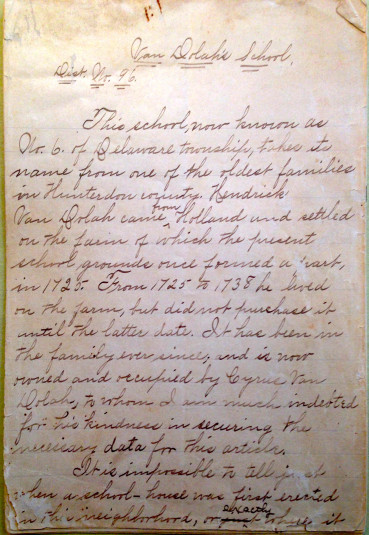
She wrote that the second schoolhouse was built on land of Gideon Brewer, “halfway between the corner and Mr. Brewer’s house, along the road to Mt. Airy. The “corner” was Dilts Corner, and the school stood “in the first field on the left on the road to Mt. Airy, about 100 yards” from the crossroad at Dilts Corner.
“G. M. Brewer” appears on the Beers Atlas of 1873 at a house located just southeast of Dilts Corner (Block 58 lot 10). This was Gideon M. Brewer (1827-1900), son of Wm. S. Brewer and Sarah Moore. That property was once part of the Barber family plantation. John Barber (c.1720-1795) was probably one of the first children to be born in Amwell/Delaware Township. He was the son of early settlers Samuel Barber (c.1690-1751) and Eliada or Alida Johnson (c.1695-aft 1782). John Barber and his wife Magdalen Johnson had nine children from 1742 to about 1760. A school house on their property would certainly make sense. But this period of time, 1742-1760, is much earlier that the date given for the second school in the vicinity of Sandy Ridge.
And the location puts it well to the south of where the first school stood, if indeed it was located “on the edge of the ravine,” as Snell wrote. As far as Miss Groff was concerned, Snell wrote “a very loose statement, and there seems to be but little foundation for any part of it except the date of building the present house, which is evidently correct.”
Before continuing, I’d like to introduce Laura A. Groff. Miss Groff was born in 1874 to Henry and Rachel Groff. She was a school teacher herself until her marriage, at a rather late age, to Percy L. Bush in 1910. Percy Bush was the son of local historian Egbert T. Bush, and the couple went to live with Mr. and Mrs. Bush Sr. near Sandy Ridge. I am sure that Egbert T. Bush was gratified to get a history-minded daughter-in-law.
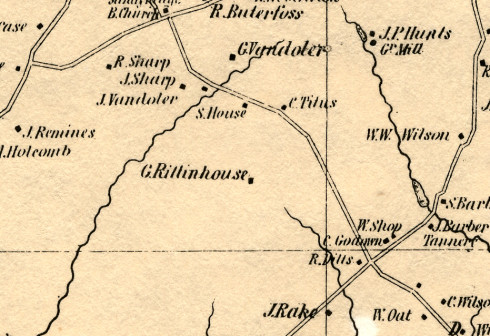
According to Laura Groff, the second school house closed in 1822 when a third schoolhouse was built on ground leased for 99 years by Catherine Van Dolah. The lot was only 1/16th of an acre, but later was enlarged to a half acre. It appears on the 1851 Cornell Map detail above, sitting by that Sandy Ridge ravine that Snell mentioned. Catharine Taylor Van Dolah was the wife of Henry Van Dolah who died in 1815, leaving her with ten fatherless children. In 1822, when she leased the school house lot, the youngest child was only four years old, and there were five altogether who were still of school age. So Catharine had good reason to arrange for a school close to home.2
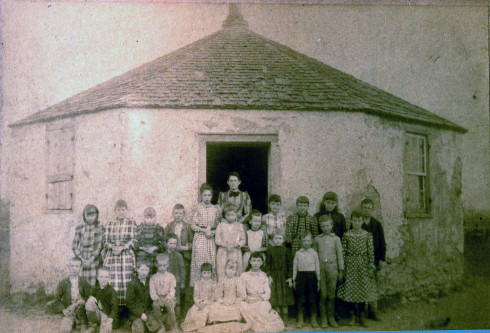
The building that was constructed in 1822 was a six-sided stone structure (not the “octagonal school” mentioned by Snell) covered with plaster. It had a pointed roof with a stove-pipe chimney in the middle. Laura Groff wrote that desks were originally set up along the walls, which was the traditional way to do it, and that “just recently” those original desks had been replaced by “modern seating . . . showing a curious and rather incongruous mingling of the old style and the new.” I assume that means the desks were arranged in rows facing one of the walls.
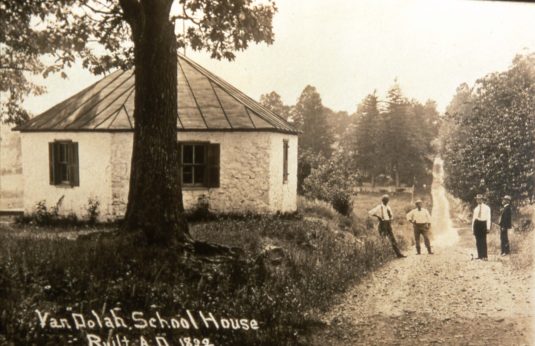 The school was named after Cyrus Van Dolah (1806-1891), a longtime member of the district and of the Township School Boards. It was his son, Cyrus Van Dolah, Jr. who assisted Laura Groff with her paper. By 1873, the school was identified as District 96. In 1886, Cornelius S. Conkling wrote a description of the school based on information provided him by the District’s clerk. I suspect that Snell also got his information from this clerk.
The school was named after Cyrus Van Dolah (1806-1891), a longtime member of the district and of the Township School Boards. It was his son, Cyrus Van Dolah, Jr. who assisted Laura Groff with her paper. By 1873, the school was identified as District 96. In 1886, Cornelius S. Conkling wrote a description of the school based on information provided him by the District’s clerk. I suspect that Snell also got his information from this clerk.
The Clerk wrote that there were three houses. The first was erected in 1780 of logs, 20 feet square. Early trustees were William Sharp, Caleb Runk, Charles Barber. The first teacher was Charles Rice. There is no account of the second building. The present house was built in 1822 of stone and repaired in 1869 for $350. Its condition was good, its seating medium. When the clerk was writing, the trustees were Elijah Holcombe, William H. Barber, Andrew Woolverton. The teacher is Mary M. Trout.
Conkling seems to have felt that its being a hexagonal school was not worth noting, perhaps a reflection on how common such schools were at the time.
The First (or Second) School House
Trustee Caleb Runk (c.1775—1835), whose own children were born 1811-1816, was the grandson of Jacob Runk and Anna Rockafellar. It was probably those grandparents who set up the pre-cursor to the Vandolah school, known as the Runk School House on Brookville Hollow Road.
Laura Groff wrote of this school house: “It is, also known that there was a school-house at a very early date, about three-quarters of a mile west of the present one, on land now owned by Thomas and Ezekiel Everitt, then owned by a man named Runk. This was know[n] as the “Runk School house.” Whether this was the forerunner of the one at the “Corner,” or whether they were to some extent contemporary, it is impossible definitely to determine. It seems probable, however, that the “Runk” house was the older of the two, and that it went down soon after the other was built.”
As Miss Groff pointed out, the date of 1780 for the first school house was probably not early enough. It certainly wasn’t early enough for the Runk school, because one of its pupils was Sen. John Lambert, who must have attended it in the 1750s.3
So, now we have 1) the Runk school house; 2) the school house at Dilts’ Corner, possibly built early enough for the children of John Barber; and 3) the 1822 stone school house on Sandy Ridge-Mt. Airy Road. Ten years after Miss Groff gave her talk, in 1905, that third house was replaced by a frame school house, very nearby.4
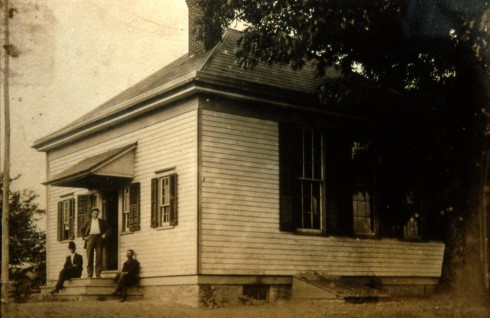
Eventually, the new school building was also taken down. When the 99-year lease expired, the school was sold at auction to Anthony Suozzo for $950. He tore the building down and reconstructed it for residential use on Brookville Hollow Road.
Like the previous school house, the newest one was also a one-room schoolhouse. It accommodated from 25 to 40 students according to one of its former pupils, Edna Kusant Garboski. The work of maintaining the building was shared by the students, jobs like sweeping the floor cleaning the blackboards, and carrying water. The water came from the Van Dolah farm, about a quarter mile away. It was carried in a bucket supported on a broom handle. Each student had his or her own tin cup. Mrs. Garboski’s mother felt this was unsanitary, and stood up in a PTA meeting to ask that a well be dug. This was very unusual for a woman to do in the 1930’s. As Mrs. Garboski writes, “only men were supposed to bring up subjects like that.” But despite resistance from those who had carried water themselves and thought it was good enough for their children, the well was dug and a pump installed. A hand pump, of course. New plumbing did not extend to the outhouse. All during the time that Mrs. Garboski attended the school during the 1930’s, the outhouse was in use.
Teachers
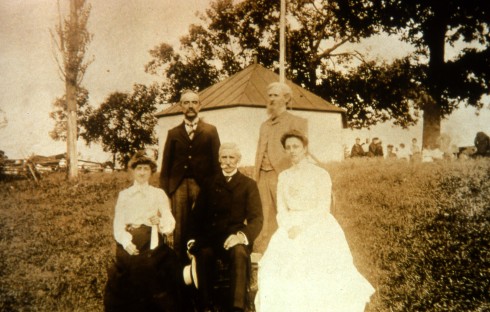
Note: The two men in the back are E. T. Bush on the left and Cyrus Van Dolah Sr. on the right. I wonder if the woman on the right might be Laura Groff.
As Ms. Groff wrote, the first teacher was Charles Rice. In 1824, Joseph Thomas was charging $1.75 per quarter per pupil, with 30 cents additional for firewood. Laura Groff listed the teachers she was aware of, up until 1895. She noted there were “many missing links.”
Teachers in the “old house,” that is, the school house in use before 1822, were: James Mounteer, __ Cuddy, __ Irasco, Alex. Lawry 1799, Rhoda Barcroft 1802, J. Coryell 1803, John H. Lambert 1807, William Doyle 1808, Joseph Howell 1808, Joseph Larew 1811, Joshua Anderson 1812, Hugh Dunn 1813, Thomas Betts 1814, Benjamin Warruke [?] 1815, Joseph Thomas, Abram Stryker 1821, also Peter Larue.
Peter Larue, Joseph Thomas and Hugh Dunn also taught in the “new house.” According to Ms. Groff, Dunn taught there in 1861, 48 years after teaching in the old house. It is hard to believe that could be possible, but it is true that many 19th-century school teachers were quite young, having only just finished their own schooling. If Dunn was 15 years old in 1813, which is quite possible, he would have been 63 in 1861, which is very old for a school teacher, but not out of the question.
Hugh Dunn was mentioned by Egbert T. Bush in his article “Among Old Books & Papers of the Van Dolah Family.” He wrote that Dunn sent a bill for $1.55 for tuition to Henry Van Dolah in 1813. According to Bush, at that time Dunn was teaching in the school house at Dilt’s Corner. And he also noted that the hexagonal school built in 1822 was the third one to serve Sandy Ridge. He observed that the 1822 school house was built by mason Ezekiel Everitt and carpenter David Morgan.
The only Hugh Dunn I know of that could have taught school in both school houses was born about 1786, in Middlesex County, and died on May 21, 1876 in Sand Brook, age 90. Which means he was 27 in 1813, and an astounding 75 in 1861. But then consider, the Civil War had begun, so perhaps finding a school teacher that year was so difficult that the old man had to pitch in.5
Hugh Dunn was the son of Justus Dun and Experience Stelle of Piscataway. He married Hannah Dilts on April 26, 1808, daughter of Peter Dilts and Mary French. They had three daughters: Mary Ann 1808, Sarah 1809 and Ellen c.1815. Daughter Mary Ann married Jeremiah Trout about 1828. Daughter Sarah married Isaac Horne about 1835. And daughter Ellen married John S. Bush about 1830. He was the uncle of Egbert. T. Bush. So, now we have a line from Hugh Dunn to E. T. Bush.
Teachers in the Second School
The following are teachers identified by Laura Groff. She did not include herself, as she did not start teaching there until 1898, after her history of the school was written. Some of these people have longer biographies here than others. That is partly because of information provided by Ms. Groff, and partly because I decided that the better known teachers had less need of extended treatment. The many teachers who do not have biographical information included are ones I have no information on. I had trouble sorting out Ms. Groff’s list of teachers. She gives the year that some were teaching, but not for most of them. And they seem to be jumbled together in a non-chronological order. So I alphabetized them. I would love to see the original source that Ms. Groff used to list the teachers.
John Campbell Verona De Ward Banes (1846). Mrs. Groff wrote: “Mr. Banes is famous chiefly for the length of his name, which he is said to have taken great delight in writing out in full on most occasions.”
Charles D. Barber. He was the son of John Barber Esq. and Anne Skillman, born in 1832. He died in 1881 and is buried in the Barber Cemetery. Married Henrietta Warford (1821-1916) who is also in the Barber Cemetery.
Lafayette Beans. No information; possible relative of Mr. John C. V. D. Banes?
Egbert T. Bush. He was not included in Ms. Groff’s article, which surprises me. I have not been able to find a record of when he was at the school. Judging by the photographs, he spent a fair amount of time there, and was a teacher in the old six-sided school.
O. P. Chamberlin. Prominent Flemington lawyer, Prosecutor of Pleas and Judge of the Court of Common Pleas. Octavius Pearl Chamberlin (what a fabulous name!) was born May 16, 1832 to Ampleus B. Chamberlin and Elizabeth Myers, who were living near Locktown at the time. This is surprising, since there was a school in Locktown.
Elias L. Dalrymple (1889). Egbert T. Bush wrote a moving biography of him for the Hunterdon Co. Democrat, which was published on Nov 28, 1929. Dalrymple died the next year at the age of 89. He took up teaching after his health foreclosed the blacksmith occupation he had been following. He was also a Civil War veteran. His parents were Samuel Dalrymple and Mary Ann Lennard. His mother died in 1843 and his father in 1845. He went to live with John S. Dalrymple until he was 18, but Mr. Bush did not say whether there was a relationship between Samuel and John S. Dalrymple.
Howard B. Horne (1891). Born about 1870 to Theodore M. Horne and Mary Katherine Moore. Theodore taught at the Summit School in Kingwood in the 1860s. He moved to Newark and became a stenographer sometime before his marriage in 1896 to Mary L. Belllis, daughter of Stewart Bellis and Susan E. Wilson.
Irasco. About the teacher named Irasco, Mrs. Groff had this to say: “Irasco, whose first name has been lost through the ravages of time, has gone down in local history as the first man in this vicinity that ever ventured to tempt both fate and ridicule by cutting his potatoes before planting them. Tradition says that he was much ridiculed until the digging time, when the laugh was all on his side of the patch.”
Mahlon Lear/Lair. Mahlon Rittenhouse Lair was born in 1825 to William Archer Lair and Elizabeth Rittenhouse. In the 1850 census he was 24 years old, living with his parents and employed as a teacher. He married Sarah M. Mason in 1853, but divorced her after 1860, and went to Kansas where he worked for the Pony Express. He apparently returned to Delaware Township, for he died there in 1886. (I can’t say exactly where that date comes from, but I suspect I found it in the Deats Genealogical Files. Deats noted that he had a diary, which would certainly be worth reading.)
George H. Larison. Larison was born Jan. 4, 1831. He became a noted minister and physician of Lambertville, as well as an active local historian. He was pastor of the Sandy Ridge Baptist Church when he died on March 7, 1892.
John S. Lundy (1839). Possibly John Stockton Lundy (1819-1855), son of Amos Gregg Lunday and Abigail Stockton. He left Hunterdon and died in Champaign Co., Ohio.
Robert Mc Aulay. He was born about 1821 in Pennsylvania, and was listed in Delaware Twp. censuses for 1850 & 1860. He sold land to Rev. Jos. Wright sometime before 1868. Since his wife Nancy was living alone in 1870, I assume he died before that year.
Sally Naylor (1829) Born about 1806 to David and Charity Naylor; married Henry Schomp)
Sally Paxson. Possibly Sarah A. Paxson, born about 1835, living in Bucks County in 1856 when she married Horace Smith, hotel keeper of Raven Rock. I know little about the Paxson family.
Jesse C. Reed. My best guess is that this is the Jesse C. Reed born 1793 to Asa Reed and Mary Schamp, and married about 1815 to Rachel Moore, d/o Josiah Moore and Mary Lake. He served as the County Surrogate, and died on Oct. 26, 1854 and was buried at the Sandy Ridge Cemetery with wife Rachel, who died on Aug. 25, 1876.
Charles Rice. The Conkling Report stated that he was the first teacher, while Ms. Groff gave him the year 1834.
Emily Risler. Born 1836 to Dea. John Taylor Risler and Keturah Rittenhouse. She was probably a teacher before marrying in 1865 John C. Yawger. She died in Philadelphia in 1907.
Wilson Rittenhouse. Born 1813 to Jonathan Rittenhouse and Delilah Bray, farmer of Delaware Twp., one-time owner of today’s Dilts Farm. Daughter Mary Jane, by first wife Rachel Lambert, was also a teacher here in 1890. He died in 1881. Wm. Rockafellow—there are too many of this name to identify the school teacher.
George Runk. Possibly George W. Runk (1816-1894), son of Caleb Runk and Margaret Curry. He involved himself in Whig politics in the 1840s, and was a carpenter. He also had a son George W. Runk Jr. born about 1857 who might have been the teacher.
Mansfield Sheppard. Born 1854, son of Wm. Shepherd and Elizabeth Ann Conover, married Susan Pegg in 1897. In the 1880 census he was 23, living with parents and listed as a farmer. He died in 1913.
Gardner J. Snyder (1892). He was born about 1868 to Wesley W. Snyder and Emma Johnson. His wife was Elizabeth Amy Lair, although I have not been able to connect her with the Hunterdon Lair family. Gardenr and Elizabeth were living in Bergen County by 1900, where they remained.
Henry F. Trout. Henry Trout was the uncle of Tillie Trout below, brother of George F. Trout, son of Jeremiah Trout and Mary Ann Dunn. He was born 29 July 1829; married Mary M. Case about 1848, and died 1 Sep 1872. Buried in the Sand Brook Cemetery, while wife Mary, who died in 1910 is buried at Sandy Ridge.
In 1863, the Democratic Club of Delaware Township was created, with a president (Joshua Primmer), and vice-presidents from each of the township school districts. The 3rd or “Vandolah’s” district was represented by Rev. Henry F. Trout.
Tillie Trout. This is might have been Matilda Trout, born about 1859 to George F. Trout and Sarah Moore, residents of Delaware Twp. in 1860, but gone to Sussex County, Delaware by 1870. Matilda was counted with the family that year, age 11, but in 1880 she was 21, living with her grandparents John P. Moore and Anna Pierson. She was “at home,” and not yet a teacher. She was probably named for her mother’s sister Matilda Moore, born April 7, 1839, died Feb. 27, 1866 and buried at Sand Brook.
[Jacob] Morgan Vanderbilt. I do not know who his parents were, but about 1843 he married Moykee Hoppock, daughter of Jacob Hoppock and Bernice Williamson. She died young, in 1845. He was identified as a school teacher in the 1870 & 1880 Delaware twp. censuses. He died in 1883 in Tinicum Township.
Cyrus Van Dolah (1832) Born 1806 to Henry Vandolah and Catherine Taylor, and good friend of Egbert T. Bush.
Anna Waterhouse. I can only guess that she might have been the daughter of Ingham Waterhouse Jr. and Frances S. Calvin. If so, she would have been born about 1851, according to the 1860 census.
Wm. Wigg, autumn 1861. William Bray Wigg, 1836-c.1910) son of Elder James W. Wigg and Huldah Bray Rittenhouse. I have written about this family, including William, in “A Scandal in Baptistown.”
Wm. D. Wolverton (21 Dec 1834-20 Jul, 1922, bur. in Sandy Ridge Cemetery). Ms. Groff wrote that he grew up in Sandy Ridge, studied medicine and became an army surgeon in 1861. By 1895, he was an army major stationed at Vancouver Barrack in Washington. He was the son of Andrew Wolverton and Rebecca Dilts, and not long after the end of the Civil War married Anna Eliza Wilson, daughter of James Willson and Mary Laing. Their first child, Florence, was born about 1869 in New Jersey, but the next two, Mary and William, were born in Dakota Territory. The family was there by 1870, before moving on to Vancouver.
Joseph Wright (20 Oct 1795 – 3 Jan 1880). Pastor of the Sandy Ridge Church, 1832-1842, and school teacher during that time.
I have no information on the following teachers named by Laura Groff: Lily Cooper; __ Devine; Maggie Felty; Sarah Green; Jonathan Hardon; James Harte; Joseph Harte (1843); R. F. Newand; Charles W. N. Regirte; and Belle Thorne.
One of the pupils at the Van Dolah school in the 1930s was Edna Kusant, daughter of George Kusant and Tillie Van Dorn, and wife of Peter F. Garboski. Many years ago, she generously shared with me her memories of the Van Dolah School.
The teachers all made a strong impression on her. They encouraged her and gave her work that challenged her. She remembers fondly Miss Pedrick, Mrs. Ellen Bodine, Miss Louise Pierson and Miss Marian Keown. There were only five children in Mrs. Garboski’s graduating class. She was so fond of the school that she was reluctant to leave it for the high school.
Louise Pierson Adams, Mr. Andrews, Olive M. Berrien, Mary Pedrick Carver, Marion Dean Errico, Henry Fisher, Laura A. Groff (1898), Vivian Faust Guest, Emily Rittenhouse Gulick, Miss Flora Hamlin, Miss Hoff, Wilda Holcombe, Mrs. Myrtle Hunt, Miss Sara Leisher, Reba Hendricks Mason, Bessie E. Melick, Mrs. Dorothy Molan, Bessie Higgins Mohr, Mary E. Pedrick (1929), Margaret Smith, Ethel Slate Schlachter, Marion Staats, Marion Keown Thornton, Mrs. Tubbs, Ellen Bodine Walker.
Prominent Pupils from the 19th Century
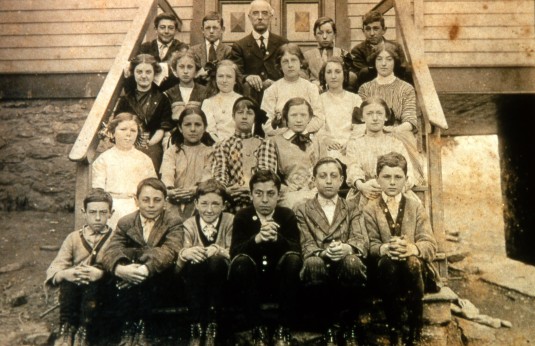
These students were identified by Laura A. Groff. Two pupils, Dr. Wolverton and Dr. Larison, were also teachers at the school.
W. H. Baker of Clinton, now lay Judge of the Court of Common Pleas
Judge John Barber, at one time Judge of the Court of Common Pleas
Judge Corle, before mentioned
Dr. Alexander Doyle, a veterinary of Hightstown
Hon. Charles W. Godown, elected to the Assembly of New Jersey in 1879. He was then a resident of Dilts’ Corner, now of Lambertville
Joseph H. Higgins, who was well known to the people of Hunterdon county for many years as the leading druggist of Flemington
Hon. John Lambert, member of the NJ Assembly
Cong. John Lambert, who is also believed to have secured his early education in the schools of this district
Dr. C. W. Larison, for many years a well known physician of Ringoes
Rev. A. B. Larison, dec’d. Dr. C. W. and Rev. A. B. were sons of Benj. Larison, late of Sandy Ridge.
Rev. Silas Larue, “of whose whereabouts, if living, we have been unable to learn.”
Hon. Charles Naylor, now of California
Rev. E. C. Romine, a Baptist minister of Philadelphia
Dr. Geo. L. Romine, a practicing physician of Lambertville
Dr. Thomas Royce now a practicing physician in Pennsylvania
Thomas Seabrook, a prominent civil engineer of Philadelphia, owner of the Seabrook farm.
Dr. O. H. Sproul, long an eminent practitioner of Stockton and elsewhere, and now Surrogate of Hunterdon county
Dr. Charles Stickney, long a well-known physician of Newark, recently deceased.
Rev. Abram Deremer Wilson, a Presbyterian minister, before mentioned
Rev. Charles Wilson, brother of Rev. Wm. Wilson
Rev. Wm. V. Wilson, a Baptist minister, now of New Monmouth, NJ
The female students did not have the opportunities that the male ones had. For Laura Groff, the prominent ones were identified by who they married. She did not mention their maiden names, so I added them.
Mrs. Ashbel Welch (Emily Delia Finney)
Mrs. J. A. Anderson (Cornelia Elizabeth Coryell)
Mrs. Myra Coryell, mother of Mayor Coryell of Lambertville; she was Myra Coryell, who married Martin Coryell
Mrs. Charles Imlay of Camden (Sarah Ann Coryell)
Ms. Groff found the names of early teachers and students in the school papers saved by Cyrus Van Dolah.6 Many were receipts for tuition and salaries for teachers. Possibly the item with the earliest date was this:
Nov. 30, 1743
Rec’d of Sarah Johnson the sum of Eighteen shillings and eight pence in full of Henry Vandolah by me John Mullen Decd Acct
The Van Dolah School in the 20th Century
A reunion was held at the octagonal school in 1902 that was very well attended, and a wonderful photograph was taken. It is a good thing that was done, because when the new school was built in 1905, the old one was taken down.
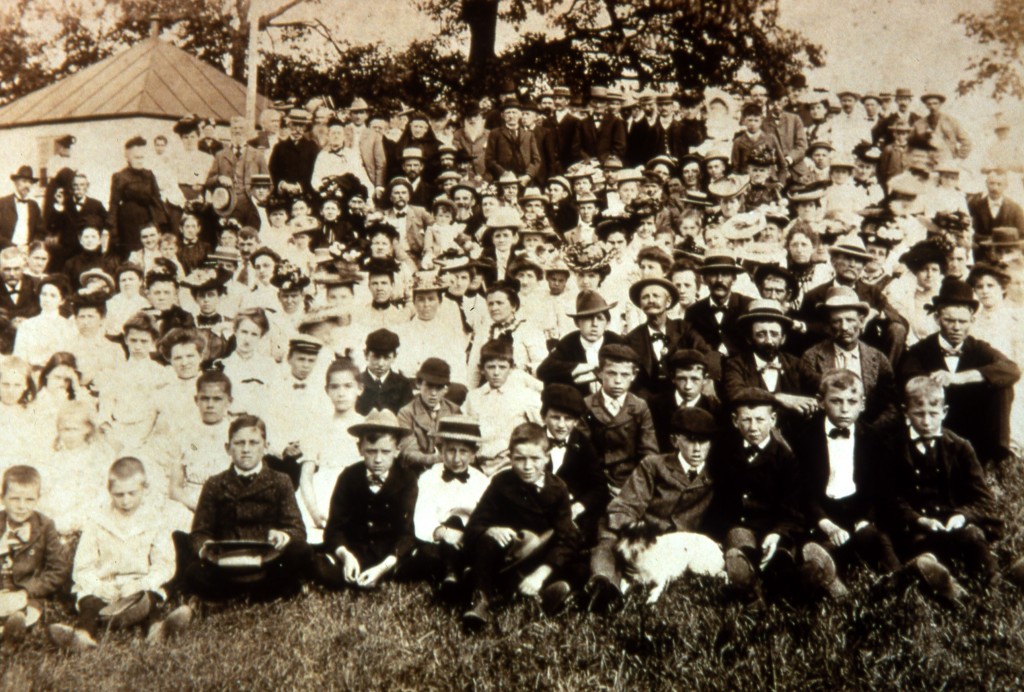
The fourth building was constructed in 1905. It was a one-room schoolhouse for 25 to 40 students. As Edna Garboski recalled, the work of maintaining the building was shared by the students—jobs like sweeping the floor cleaning the blackboards, and carrying water. The water came from the Van Dolah farm, about a quarter mile away. It was carried in a bucket supported on a broom handle. Each student had his or her own tin cup. In the 1930’s, despite resistance from those who had carried water themselves and thought it was good enough for their children, a well was dug and a hand pump installed. New plumbing did not extend to the outhouse.
Trenton Evening Times, Oct. 15, 1907, Stockton: “The report of the Van Dolah public school for the month of September follows: Number on roll, 26; percentage of attendance, 809 [that was probably a typo, and should have been 80%]; pupils neither absent nor tardy during the month: Blanch Poulson, Marguerite Stevenson and Raymond Cray, Henry H. Fisher.
The last Van Dolah school house suffered the same fate as all the others. When the 99-year lease expired, the school was sold at auction to Anthony Suozzo for $950. He tore the building down and reconstructed it for residential use on Brookville Hollow Road. Students who attended this school never forgot it. One of those students, Dave Steward, has written a poem about the school, which he has given me permission to publish here:
“Van Dolah” by D. E. Steward7
Sidehill farm and a hilltop school
Quarter of a mile apart across a brook
The piedmont woods must have looked alpine
To you packing up a little tributary
From the Delaware a 1600s league below
Camped that first night at the spring
You dreamed well it kept your name
The old springhouse and its cress is yours
In Nederlandish it was your Fontein
You built your low stone house and noble barn
And were already legend when the school went up
That for generations carried your name too
It had one room with cloakrooms and a hall
Two outhouses a belfry and a bell
Potbelly stove a coal bin in the cellar
Where a burlap bag ghost house was hung
At Halloween cornstalk rattle apple bob
Families came for evening spelling bees
At seven I won one but now have trouble
Spelling your name you Platlander
Who set it there so enduring sure
Footnotes:
- HCHS, Ms. Collection, Box 8a file 20. ↩
- For a view of the Van Dolah farmhouse, visit this Query. ↩
- E. T. Bush wrote about the home and burial place of Jacob and Ann Rockafellar Runk in his article ”Runks and Sharps are Sleeping There,” on October 23, 1930. Bush located the cemetery “on the road from Rocktown to Mt. Airy,” but judging from the 1873 Beers Atlas, the road was the Lambertville-Rocktown Road in West Amwell, where Robert Fisher’s house was located. I am rather puzzled about the distance from this location to the school house on Brookville Hollow Road. ↩
- Before listing the teachers and students of Van Dolah School, Miss Groff spent a good part of her paper describing the families who lived in the vicinity of the school. I will save that for a future article. ↩
- Even though he had to be living in or near Delaware Township in 1860, I have not found him in the census records for that year, or for 1870. I checked the children in the census records to see if he was living with them, but he was not. ↩
- This would be a good place to discuss the history and genealogy of the Van Dolah family, but that will have to wait for a future article. ↩
- published in Puerto del Sol, Vol 19, Las Cruces, Fall 1983. ↩

Dave Steward
March 27, 2015 @ 7:39 pm
Brava!!
James Arthur Martin
April 5, 2018 @ 6:50 pm
I’d like to commend the thoroughness by the author of this article. The Cyrus Van Dolah, Sr listed in this article is my GGG Grandfather. I was pleased to find the picture of him that you have posted. I have one more of him, and also of his son Cyrus Van Dolah, Jr. I’m willing to share with you. The data regarding Henry Van Dolah’s death matches my research exactly. Again, thank you for your efforts. Jim Martin